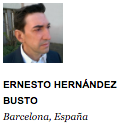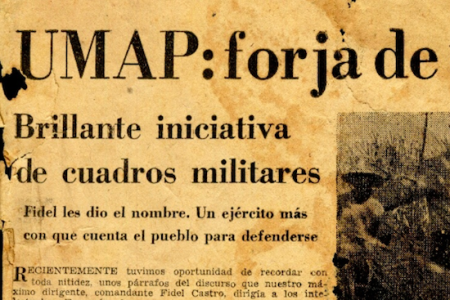 Ernesto Hernández Busto, Penultimos Días, 13 September 2016 — It seems that in Cuba one can now talk about UMAP, the notorious Military Units to Aid Production (in Spanish: Unidades Militares de Ayuda a la Producción), internment and forced labor camps where the Cuban government imprisoned homosexuals, the religious, intellectuals, dissidents and any other “suspicious elements” between November 1965 and July 1968. Gradually, people have begun to speak about the camps, to admit things and individual cases, to collect testimonies, and to make visible this sad episode.
Ernesto Hernández Busto, Penultimos Días, 13 September 2016 — It seems that in Cuba one can now talk about UMAP, the notorious Military Units to Aid Production (in Spanish: Unidades Militares de Ayuda a la Producción), internment and forced labor camps where the Cuban government imprisoned homosexuals, the religious, intellectuals, dissidents and any other “suspicious elements” between November 1965 and July 1968. Gradually, people have begun to speak about the camps, to admit things and individual cases, to collect testimonies, and to make visible this sad episode.
The psychologist Carolina de la Torre, a professor at the University of Havana, is about to publish the fictionalized story of her brother, Benjamin de la Torre, who committed suicide in 1967, just after leaving one of these camps. In a recent interview she recounted the difficulties in “finding out and writing about this episode in my own country.” In effect, for too long any investigation into this thorny episode in Cuba’s history has been avoided, while the importance of information and witness accounts that came to light off the island was called into question. continue reading
The topic has always been “suspicious,” and this situation only began to change after official recognition from the victimizer: in an interview with the Mexican newspaper La Jornada, on 31 August 2010, after some hesitation and rhetorical circumlocutions, Fidel Castro declared publicly: “I am the one responsible for the persecution of homosexuals we had in Cuba… We did not know how to judge… Systematic sabotage, armed attacks, were happening all the time; we had so many and such terrible problems, problems of life and death, you know, so we didn’t pay enough attention.”
In fact, there was an excess of attention. For the young Cuban historian Abel Sierra Madero, UMAP cannot be understood as an isolated institution, but as a part of a project “oriented to social and political control. That is, as a technology that involved judicial, military, educational, medical and psychiatric mechanisms.” In recent research published in the magazine Letras Libres, and later, in an expanded version for Cuban Studies, Sierra Madero, using a relentless collection of testimonies, lucidly analyzes the Castro regime’s ideology that supported these supposed “academies to produce macho men.”
It was not just a question of a homophobic or exclusionary discourse that proposed, for example, to expel from higher schooling “counterrevolutionary and homosexual elements,” and to prevent their entry into the university. The process of “purification” was more complex and took place at all levels.
Once the purges of the universities were finalized, young people who stood out for a wide range of reasons – which included everything from long hair to being Jehovah’s Witnesses, listening to “the enemy’s music” or not being “incorporated” (not having fixed work or belonging to mass organizations) – remained “exposed and at the mercy of the State.”
The Committees for the Defense of the Revolution (CDRs) were charged with conducting a census to identify the “disaffected”, informing on them was encouraged through a National Information Center, and all this data ended up being shared with the Ministry of the Interior and Revolutionary Armed Forces, which were charged with forced recruitment.
Quite simply, there was no escape. Rather than a “lack of attention,” it was the most attentive Orwellian machinery that was set in motion to concern itself with those who did not fit into the mold of the “New Man.”
Sierra Madero’s research focuses on this concept, associated with “a broader ideological camp of social homogenization in which fashion, urban practices of sociability, religious creeds and an attitude toward work were key elements in harmonizing with a normative official vision.”
The testimonies collected – including those of the various psychologists who consulted in the camps – trace a hellish scenario: from forced hormone therapy treatments to an enormous plan of “Revolutionary hygiene” that turned the internees into an almost slave labor force, or subjected to them to behavioral and reflexological experiments, in which they came to use electroshock treatments. Other witnesses speak of tortures using electrodes and treatments that involved insulin-induced comas.
Recently, the government magazine Temas (Themes) dedicated an article by its director, Rafael Hernández, to “the time of the UMAPs.” In it, he affirms that there were more than 25,000 internees “among the more than 70 camps, scattered across the plains of Camagüey.” The number is very conservative but there is no way to contest it.
In a last year’s interview in El País, famous Cuban singer Pablo Milanés talked about his own experience in UMAP and mentioned “40 thousand” internees. Two former Cuban intelligence agents quoted by the scholar Joseph Tahbaz (Dartmouth College) in the most comprehensive study about this subject, Demystifying las UMAP: The Politics of Sugar, Gender, and Religion in 1960s Cuba, have estimated approximately 35,000 UMAP internees.
Last November, the journalist José Jasán Nieves reported about a meeting between several former inmates of the camps, now associates of the Christian Reflection and Dialog Center, and their guards, who at the time were young Revolutionaries convinced they were carrying out an important “task of the Revolution.” One of the guards, a former sergeant, has been a pastor in the Brothers of Christ Church for more than 25 years. And he cries out, of course, for forgiveness.
It appears, however, that on this issue there are different ideas about memory and forgiveness. Last December, after seeing a documentary on Mariela Castro and “The Revolution of Homosexuals in Cuba,” the LGBT activist Jimmy Roque published in the on-line newspaper Havana Times, an article asking Raúl Castro to apologize and accept his responsibility for the internment of homosexuals in the UMAPs. “Now is the time to ask forgiveness for this act of penalization, exclusion and punishment to which thousands of homosexuals and Cubans with ‘improper conduct’ were subjected,” the activist wrote, quoting the title of Néstor Almendros and Orlando Jiménez Leal’s famous documentary about this subject –from 1983.
In his article, Roque also referred to a supposed investigation into the matter that CENESEX, directed by Raul’s daughter Mariela Castro, had been pushing since 2011: “Where is this investigation? How many people have been interviewed? Who is performing it? When and where will the partial results be presented (along with those from now until the end of the study)?”
Two months later, in February, another Cuban activist, Yasmín Portales Machado, dared to quote a fragment of Roque’s article in his blog Proyecto Arcoiris (“Rainbow Project”) which deals with sexual diversity and is hosted on the Cuban government’s platform Reflejos. The text was censored and the blog closed after a succinct explanation about how it had violated “the norms of participation on the site” with a text “defamatory to the Revolution.”
In closed forums, or in publications with no real or large impact within Cuba, people then began to talk about the issue, but always quietly. They recognize that something was wrong. But there is still censorship and zones of silence. There is no mention, yet, about the origin of UMAP – and of many other similar “experiments” that seem inseparable from the construction of “a new society”: the devastating power that has been exercised by the Cuban State against all forms of dissent. The way in which one life is suddenly reduced to nothing, no longer matters, is no longer accounted for, and all violence then becomes legitimate, “natural,” exempt from responsibility. Because if we go there, how can we ignore the current repression against the dissidents, and the monopoly of the political voice and the systematic violation of human rights on the island?
Behind the “UMAP phenomenon” there was not, as one analyst recently recovered from several decades of amnesia said, a “perfect storm” of circumstances specific to the ‘60s, but the idea that any behavior that did not fit into the mold of ideological unanimity was not only reprehensible but punishable: it deserved to be suppressed, isolated, subjected to the worst humiliations we could imagine. The same way of thinking erupted again in 1980, with the events of the Mariel Boatlift, and survives today as the ideological basis of the repressive forces.
I hope we don’t have to wait another 50 years for the day when some digital publication, not greatly read in Cuba, comes to think that this beating of dissidents that goes on today wasn’t a good thing either.
For more from Penultimos Días click here.
Ernesto Hernández Busto
Barcelona

